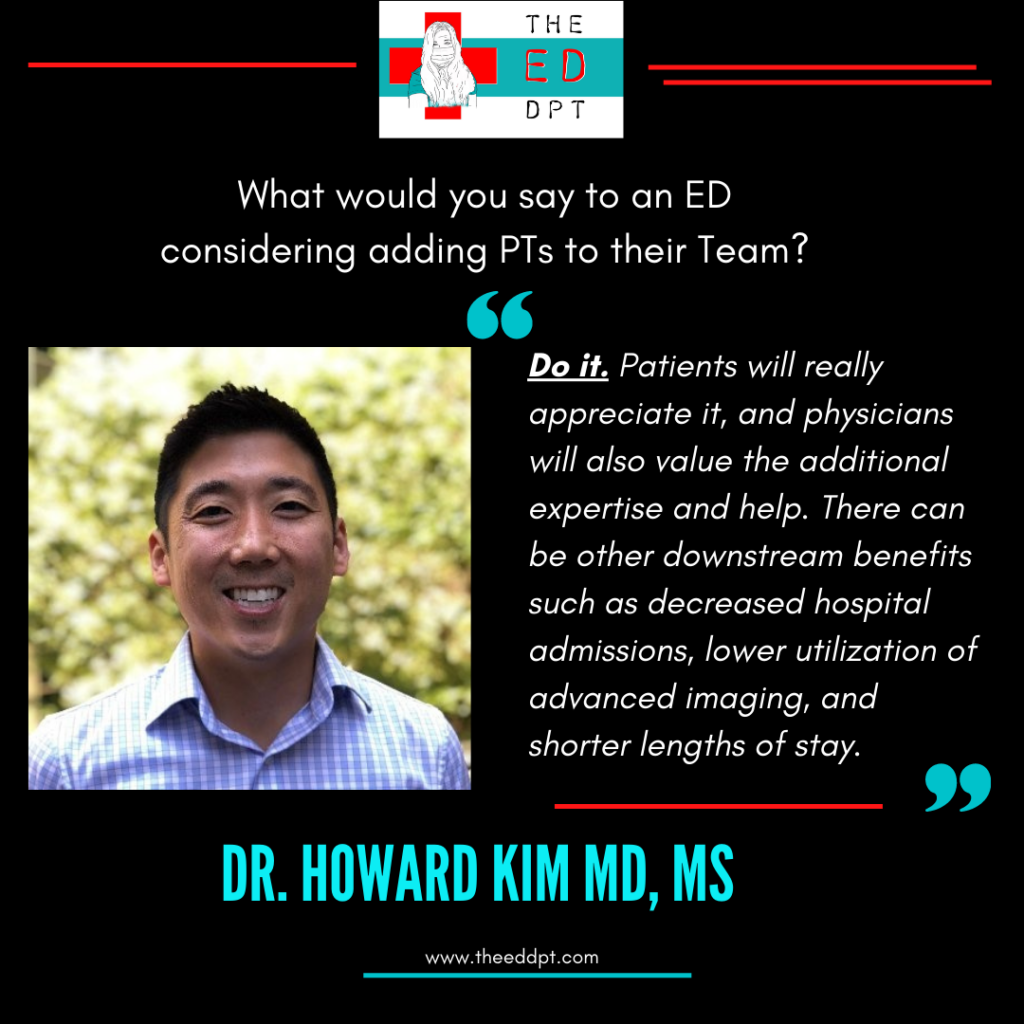Meet Dr. Kim
Share your journey to becoming an ED physician.
I rotated in the emergency department in medical school and really loved the fast pace, culture, and breadth of clinical presentations and patients. I matched in emergency medicine residency at Denver Health, where our time was split between a busy level 1 trauma county hospital (Denver Health) and a typical quaternary referral academic hospital (University of Colorado). I was really interested in the idea of research to improve the way we administer emergency care and improve patient outcomes, so I then went on to complete a research fellowship at Northwestern, which is where I discovered the care model of ED physical therapy and began my research program in it.
Describe your practice setting and ED PT model.
The emergency department at Northwestern Memorial Hospital is your typical medical school-affiliated hospital, with access to a broad range of specialists and resources – and I definitely recognize some of the privileges (and limitations) associated with that. We’re situated right in the middle of downtown Chicago and see about 91,000 visits annually. We do have a dedicated ED physical therapist during normal business hours. The ED PT care model operates on a consultative basis (i.e., the treating physician requests that the physical therapist evaluates a patient for a given problem), although our current randomized trial is evaluating an “embedded” physical therapist intervention – which is a fancier way of saying that the PT will evaluate all patients with low back pain rather than only some patients with low back pain – but that is for this research study only.
Can you tell us a little about your current research around EDPT?
So the randomized trial I mentioned above evaluates the effect of an embedded ED PT intervention on patient-reported outcomes in the three months following an ED visit for acute low back pain. We are measuring pain-related disability and opioid medication use. We’re also conducting an observational trial of ED physical therapy for vertigo and dizziness complaints and measuring patient outcomes over three months of follow-up.
How did you come to be involved in research around ED PT?
My initial research interest focused on optimizing the management of acute pain and the appropriateness of opioid prescribing, so you can see how this eventually led to my interest in ED physical therapy as an innovative care model to address both. I was fortunate to come to Northwestern, which had an ED PT program running as a pilot when I arrived.
Why do you think this is a valuable practice area?
Patients really enjoy the experience of seeing a physical therapist in the ED and have specifically identified that they value the PT’s expertise and training, the personalized time and attention they are able to give to the patient, and the provision of a plan going forward. For PTs considering different practice settings, the emergency care environment might be a good choice if you enjoy a diversity of patients/clinical pathology and a fast-paced environment. In general, the ED culture is very laid-back and relatively informal with a flatter hierarchy than some of the other practice areas I’ve seen.
What would you say to an ED considering adding PTs to their team?
Do it. Patients will really appreciate it, and physicians will also value the additional expertise and help. From an operational perspective an ED PT position can be self-supporting based on the number of additional consultations generated, and there can be other downstream benefits such as decreased hospital admissions, lower utilization of advanced imaging, and shorter lengths of stay.
What strategies for communication with the medical team do you find to be the most effective in this environment?
I think just understanding that the ED team really wants to hear your opinion on the diagnosis and recommendations for care is a great place to start. As I alluded to before, we generally have a laid-back culture and flat hierarchy and will readily acknowledge that you have unique expertise in whatever clinical area we’ve asked for your help in. The ED environment is always really busy and we’re doing a thousand things at once, so we’ll always look like our hair is on fire – but just knowing that we see you as value added is a great mindset to come from. In terms of actual communication strategies, I would say keep it short and simple? We tend to be more interested in the punchline than the plot development/background. And then if there’s disagreement, just standard communication principles: try to understand where both parties are coming from and keep things focused on the patient.
What was your biggest team win in the ED?
There’s way too many to share honestly. But I always love it when our ED physical therapist is able to help us avoid an unnecessary hospitalization or accelerate a patient’s care (and thereby make their hospital stay shorter). I’m thinking of one particular case, in which a patient had simultaneous orthopedic injuries to their lower and upper extremities that would have otherwise required an inpatient stay. But a quick PT evaluation and social work coordination in the ED allowed us to arrange for a transfer to an assisted living facility, obtain some durable medical equipment, and set up home PT – all on a Friday. It’s also great when our ED physical therapist can drastically improve dizziness symptoms for patients with BPPV during their ED visit and avoid the need for a CT or MRI. These patients can sometimes go from vomiting and bed-bound to walking out of the ED with a smile.

